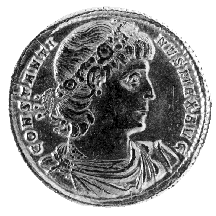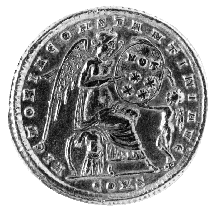



(128) Constantine I (the Great) - AV solidus, A.D. 336-337, 4.42
g. (inv. 91.240).
Obverse: Draped and cuirassed bust of Constantine r., wearing rosette diadem;
CONSTANTINVS MAX(IMVS) AVG(VSTVS): Constantine the Great Augustus.
Rev. Victoria seated on cuirass r., inscribing shield held by winged genius
VOT(A)/XX/XX: vows for forty years of rule; VICTORIA CONSTANTINI AVG(VSTI):
Victory of Constantine Augustus; in exergue, CONS: Constantinople.
Provenance: Münzen und Medaillen, 1981.
Bibliography: P.M. Bruun, The Roman Imperial Coinage 7: Constantine and
Licinius AD 313- 337 (London 1966) 108.
Constantine was the son of Constantius, an army officer who became Caesar
and one of the rulers of the tetrarchy in A.D. 293 (see no. 125). When Constantius
died in A.D. 306, the army proclaimed Constantine emperor, but it was not
until the complete dissolution of the tetrarchy and his defeat of several
contenders to the throne that Constantine finally emerged as sole Augustus
in A.D. 324. The true nature of his religious beliefs is still debated,
but Constantine was a patron and defender of Christianity, and in his reign
the last specifically pagan types on coins die out.
In A.D. 309-310, in an effort to stabilize the badly devalued currency of
the time, Constantine began issuing a new, somewhat lighter gold coin, the
solidus, which was to become the standard gold coin until the tenth century
A.D. The new capital at Byzantium, which Constantine dedicated and renamed
Constantinople, now became a major mint of gold coinage. The mint mark CONS
indicates that this solidus was issued there.
Constantine's portrait type constitutes a clear break from the tough soldier
types of the tetrarchy. His clean-shaven face and hair combed forward in
separate locks over his forehead recall those aspects of the portraits of
Trajan (see no. 90). At the same time the upward gaze recalls the coin portraits
of Alexander the Great, which served as prototypes for the divine ruler
portraiture of much of the Hellenistic age (see no. 45). The diadem, of
which this is the most elaborate type, was adopted by Constantine and the
members of his house as a new symbol of sovereignty.
The reverse of this coin, struck in A.D. 336-337 for Constantine's tricennalia
or thirtieth anniversary of his acclamation as emperor, records vota
or prayers for ten more years of rule; the four X's that Victoria inscribes
on the shield refer to a total of forty years. Constantine, however, died
the year the vows were undertaken.
B.H.



All contents copyright (c) 1996.
Lawrence University
All rights reserved.